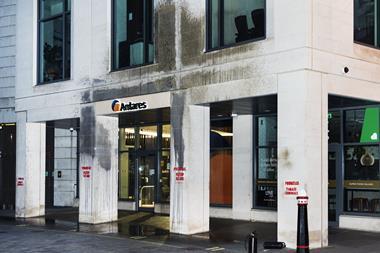Although plastic free materials are more attractive from a net zero perspective, ditching plastic in claims repairs could come at a cost for insurers and policyholders
By editor Katie Scott
In October 2021, the UK government outlined its ambitions to reach net zero greenhouse gas emissions across the country by 2050.
Following this, in September 2022, it commissioned an independent report – led by member of Parliament for Kingswood Chris Skidmore – to take a temperature check of progress to date considering the onslaught of macroeconomic factors, such as the Russia-Ukraine war.
Skidmore’s final report, which was published in January 2023, emphasised that the government’s 2050 goal is still very much a focus and that becoming a net zero nation “is the economic opportunity of the 21st century”.

“Ultimately, the benefits of net zero will outweigh the costs,” Skidmore wrote.
Although “insurers clearly want to tackle climate change and carbon reduction is increasingly high on the industry’s agenda”, there is still more for the sector to do around removing plastic-based materials from repairs in the claims process, Philip Barmby, managing director of building and construction consultancy Brawdia, told me.
Barmby feels that the use of plastic-based materials in the construction sector is hampering the UK’s sustainability objectives and that the insurance industry can help combat this roadblock by looking at its claims processes.
Describing the use of plastic in the construction sector as “a systemic issue”, Barmby said: “There’s no shortage of evidence about the negative impact of plastic on the environment.
“Whilst incredibly versatile, it also has a huge carbon footprint - not least because of the fact that 99% of plastic is produced from non-renewable sources and disused plastic tends to end up in landfill. Plastic can contribute to water, land and air pollution.
“It’s estimated that over eight billion tonnes of plastic have been produced since the 1950s - this will likely continue increasing as demand grows. Construction shows no sign of abating.”
A report published by the government’s Environment, Food and Rural Affairs Committee in November 2022 referenced statistics which found that the UK produced over 2.5 million tonnes of plastic packaging waste in 2021.
A costly change?
According to not-for-profit organisation Changing Streams, plastic is most commonly used for cladding panels, cables, pipes and gutters, windows and doors, shuttering, wall linings, floor coverings, ceiling panels and roof coverings – all elements that may need repair following a property flood or fire claim, for example.
Some of the main types of plastic used for these items include acrylic, polycarbonate, expanded polystyrene and polyvinyl chloride (PVC), to name a few.
Barmby noted that to date, cost has been the main driver of why plastic materials have been used for repairs rather than other less carbon intensive options.
“There have always been alternatives [to plastic materials], however the challenge is cost,” he explained.
Read: Construction sector requires support from insurance firms in UK’s net zero transition – UKGBC
Explore more news analysis here, or read sustainability-related content here.
“For example, you can make sash windows out of wood or PVC, or you can make piping out of steel or plastic. The issue is that wood and metal are much more expensive than plastic - particularly at the moment.
“Plastic is used because it’s cheap, versatile, durable and water resistant. Alternatives such as wood and metal are much more expensive and, in some cases, not as versatile – [although] they have both been used very effectively in construction for hundreds of years.”
Insurance impact
For Barmby, the claims sector is starting to take note of the impact of plastic materials in its repair chain and alternatives are being sourced where possible.
“In our meetings with brokers and insurers, implementing sustainable repairs is something we will proactively talk about and we are increasingly being asked to factor such considerations into our proposals and discussions,” he explained.
“I would envisage that, in line with this, there will be a growing interest in reducing the use of plastics.”
Despite this sustainable mindset switch, Barmby added that “the big challenge is cost”.
He continued: “Insurers need to approach repairs in a way that is commercially viable and will, of course, be conscious about the potential knock-on impact on costs for policyholders. So, it’s not a straightforward issue.
“In the high net worth market, repair budgets are generally higher and, therefore, using non-plastic materials tends to be more viable and in line with the original materials used on a property – for example, wooden sash windows [or] steel piping.”
Changing Streams believes that simply swapping out plastic-based materials is not enough to support the UK’s transition to a net zero economy.
Read: Brokers need more transparency and consistency with ESG client data
Explore more news stories here, or read sustainability-related content here.
Barmby added that the organisation also advocates initiatives such as plastic audits, site waste management plans, workforce education, reusing packaging and avoiding single use plastics to help the UK achieve its sustainability goals.
Although the use of green, recycled car parts has swiftly become more commonplace in the motor insurance market, the use of plastic free materials for property repairs has not really been loudly spoken about by industry commentators so far.
With high claims inflation and the cost of living already impacting premiums and purse strings, switching to more expensive – albeit more sustainable – options away from plastic simply may not be viable for either insurers or policyholders.
Barmby said that alternatives to plastic are increasingly hitting the materials market, however, so there is still hope that a balance can be struck between spending to achieve sustainability and having to remain with the old guard to ensure completed repairs on budget.
It will be interesting to see how this facet of the net zero transition evolves.
Hosted by comedian and actor Tom Allen, 34 Gold, 23 Silver and 22 Bronze awards were handed out across an amazing 34 categories recognising brilliance and innovation right across the breadth of UK general insurance.



















































No comments yet